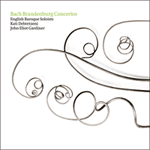
Welcome to Hyperion Records, an independent British classical label devoted to presenting high-quality recordings of music of all styles and from all periods from the twelfth century to the twenty-first.
Hyperion offers both CDs, and downloads in a number of formats. The site is also available in several languages.
Please use the dropdown buttons to set your preferred options, or use the checkbox to accept the defaults.

| The English Baroque Soloists, Sir John Eliot Gardiner (conductor)» More |
An oddity about this concerto is the way the balance of the solo instruments seems to change in the course of the piece – perhaps a sign of the diverse origins of the work (an early version survives which lacks the third movement and part of the last). But it might equally represent Bach’s way of demonstrating the diversity and malleability of the genre at the outset of the collection. The piccolo violin (tuned a third higher than the standard string pitch for these concertos) first comes to prominence in the second movement, a beautiful, affecting lament that – with its piquant cross-relations – seems to all but follow a text which lies just beyond our ears. In the third movement the high violin appears in a more virtuosic light, but after this point it disappears again. This movement is also known as the opening chorus of the secular Cantata 207, ‘Vereinigte Zwietracht der wechselnden Saiten’, in which vocal parts seem to have been added to the instrumental texture. However, if Malcolm Boyd’s guess is right, both this and the Brandenburg version might go back to an earlier vocal model. Thus what we hear as the third movement of the first concerto might actually be the instrumental arrangement of a chorus – something which points to the wider concept of ‘concerto’, embracing vocal, as well as instrumental, music. This suggests that we should not think of these concertos purely as abstract, absolute music: their gestures, moods and rhetorical structure should perhaps be seen in a similar light to texted music.
The first concerto, uniquely, presents a fourth movement, a set of dances interspersed with repetitions of a French-style minuet. Just as vocal and instrumental genres were closer to one another than we might think, so too were the genres of ‘Italian’ concerto and ‘French’ suite. Not only does the return structure of the minuet parallel the ritornello form of an Italian concerto movement, dances sometimes form the basis of the longer concerto movements (the third movement of this concerto has many of the characteristics of a passepied, that of the sixth concerto is like a gigue).
from notes by John Butt © 2013
 Bach: Brandenburg Concertos Bach: Brandenburg Concertos'These are undeniably Brandenburgs of flair and understanding' (Gramophone) 'The ensemble playing is a model of cohesive teamwork, but the players also shine as individuals in the many virtuoso solo passages peppered throughou ...» More |

